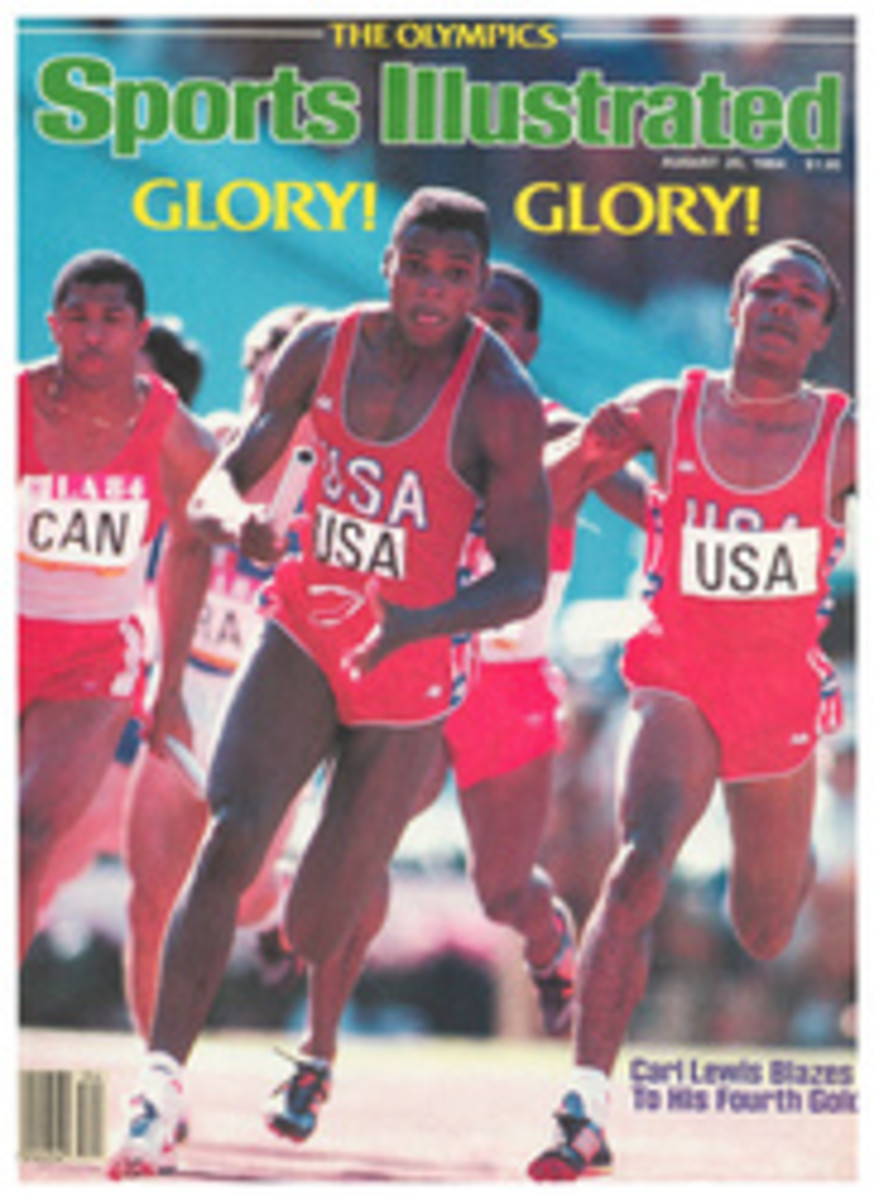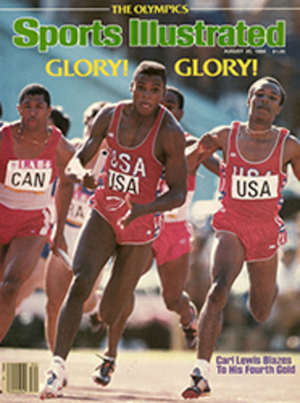
TIME WAS WHEN A BASEBALL LENSMAN WAS RIGHT IN THE THICK OF THE ACTION
There is a scene in the movie The Natural in which the hero, Roy Hobbs, played by Robert Redford, slides safely across home plate to the accompaniment of an explosion of flash bulbs. Like many of the background baseball scenes, the look is authentic. Photographers were indeed present on the playing field in those days (the scene takes place in 1939), and it is entirely probable that they would be waiting around home plate to record Hobbs's dramatic slide.
Today, in some older American League parks (Cleveland, Detroit and Baltimore), you may still see photographers walking along the fence or dugout area, or shooting pictures from there. There is no such freedom in the National League, which in 1954 banned photographers from the field during games.
There were several reasons for the National League action.
One was that better cameras, with greater flexibility, were being manufactured, and with the improved enlarging and processing equipment, it was felt that photographers no longer needed to work from such close range. And then there was the Cincinnati incident.
During a game with St. Louis at Crosley Field in 1954, Cincinnati manager Birdie Tebbetts engaged in a spirited argument with umpire Bill Stewart at second base on a ruling against the Reds.
The next day the exchange, expletives deleted, appeared in a Cincinnati newspaper. It was picked up by the Associated Press and distributed nationally.
"You're a lousy umpire," said Tebbetts. "You blew it in the World Series [a pickoff play in 1948 involving Boston's Phil Masi]; you blew it in the All-Star Game, and you blew it here. Why don't you quit?"
Ejecting Tebbetts, Stewart responded, "Get out of here. You blew a four-run lead and you're trying to blame it on someone else."
Tebbetts was mortified when his harsh assessment of Stewart's umpiring ability appeared in print. Stewart had been something of a mentor to Tebbetts in his minor league days, and their relationship had always been a good one. But Tebbetts was angry, too. In his view, what was said on the field was often hyperbole, spoken in the anger of the moment. He accused the umpire of reporting the exchange.
For his part, Stewart was furious with Tebbetts. He thought the Reds manager had confided in the press.
National League president Warren Giles called both men "on the carpet," according to newspaper accounts of the day, eventually fining Tebbetts for his remarks. What they soon discovered was that the remarks had been reported—accurately—by AP photographer Gene Smith, who had followed Tebbetts out to second base to photograph the argument. Asked about it after the game, Smith told a reporter what had been said, thereby explaining how it reached print.
Photographers like Smith became almost as knowledgeable about baseball and the skills, habits and idiosyncrasies of its performers as did players and coaches. In Chicago, there were often six to eight photographers on the field.
"When the first batter came up, we'd go beyond first base," recalls Tony Berardi, 78, a photographer and photo editor for Chicago newspapers for 50 years before he retired in 1971. "If a man got a single, we'd move to third base. If the man was sacrificed to second, we'd go to home plate.
"The plays at home were terrific. You were right at their level. You saw a guy leap at home. You got facial expressions and all the details. We were no more than 15 feet away from the plate, first base or third."
Photographers often got to know players and coaches better than their writing counterparts, who did not venture into the locker rooms nearly as much as they do today. Oldtime photographers in Philadelphia remember that Hans Lobert, a third base coach, would warn them of an impending play at third. "Get ready, fellows, here he comes," Lobert would say.
And, in those days, photographers got a good taste of playing field hazards, humor, controversy and anger because sometimes they were the brunt of it.
Berardi recalls a day in Chicago when Bill Terry, managing the Giants, objected to Berardi's position near first.
"He was in the dugout, and I guess he was trying to give signals to the right-fielder or centerfielder," Berardi says. "He yelled, 'Hey, you s.o.b., get out of my way.' I immediately went to the dugout. I said, 'Did I hear you call me an s.o.b.?' He said, 'Well, you were in the way.' I said, 'I don't give a damn. You either apologize for calling me an s.o.b., or I'll meet you after the game is over and I'll punch hell out of you.' Well, the plate umpire came over, and he told Terry he'd heard him call me an s.o.b. and he'd better apologize. He said I was part of the rules and was allowed to stay. Terry said I'm sorry. Later, we became friends."
Ron Kuntz, for many years a United Press (later United Press International) photographer in Cleveland, remembers a famous doubleheader in that city in 1954 in which the Indians swept the challenging Yankees and practically assured themselves the pennant.
"Casey Stengel was the Yankee manager," says Kuntz. "As his team was leaving to go back into the dressing room after the first game, Casey had his hands in his back pockets and was grimacing. I shot one picture of him. When I went to change the holder, he was raising his fists, yelling at me. Outfielder Irv Noren threw some gravel at me. The Yankees were very upset.
"At the end of the second game, Stengel yelled at Frank Crosetti, his third base coach, 'Don't let them [the photographers] come near the dugout.' A Cleveland Press photographer started toward the dugout. Crosetti had both of his hands raised, hollering at the photographer. I shot a picture of it and Crosetti saw me and chased me around the field. I escaped by way of the stands."
Harry Harris, who worked nearly 50 years as an AP photographer in New York, shot the first major league night game, in Cincinnati in 1935. For Harris, now living on Long Island, the night was memorable in several respects.
"Chuck Dressen was the Reds' manager, and I asked him, 'Do you mind if I use a flashbulb?' " Harris says. "He said it was all right. Flashbulbs were just beginning to be used then. I didn't bother to ask the umpire. I went down to first base, and the first time I let go with the flash, the umpire threw a fit and ordered me off the field.
"I said to Dressen, 'I thought you said it was O.K. to use a flash.'
" 'It's O.K. with me,' he said. 'Don't pay any attention to him. He's only an umpire.'
"I stayed in the dugout in the doorway leading to the clubhouse, where I could see the field and wait for something to happen. Sure enough, a guy comes off second, rounds third and heads for home. I jump out and head for home at the same time. I let go with another flash. That created all kinds of excitement. The umpires were mad; a special cop grabbed me. They said they were afraid I'd blind a player. The fans loved it. I got a standing ovation when they threw me out."
Also facing photographers were the physical dangers of foul balls, wild throws and overeager runners sliding past the bag at third or at home.
"I was always taught if there was a foul ball, don't look at the ball, look at the field; there will be three players converging on the foul ball," says Kuntz.
Arthur Witman, a photographer for the St. Louis Post-Dispatch, ignored that dictum during an A's-Browns game at Sportsman's Park in St. Louis in the mid '30s and regretted it—although not as much as the player involved.
"In those days they used to have the bats laid out on a couple of long boards just in front of the dugout," he says. "I was shooting 35 millimeter—it was a new idea in the business then—and I was focusing on Connie Mack, who was on the bench and using a scorecard to signal. I was kneeling on a mat with my back toward home plate on the first base side. Somebody hit a foul, and here was Mack looking up and up. I was taking pictures. All of a sudden, the catcher hit me from behind. He did a somersault over me, held on to the ball and landed on the bats, scooting the full length of the rack on his back. George Magerkurth was the umpire. He came over and told me to leave."
Bill Ingraham, a retired AP photographer in Philadelphia, was shooting pictures from third base the day lefthand-hitting Richie Ashburn of the Phils set an unofficial record for most foul balls. "It was something like 17 in a row," said Ingraham. "Richie used to drive them down there something fierce."
Philadelphia has proved especially hazardous for photographers. Ingraham recalls that Russ Hamilton, another photographer, took a picture of yet another photographer being carried off the field on a stretcher after being hit by a foul ball, then suffered the same fate himself. It was in Philadelphia a few years ago, too, that a UPI photographer in the official photo box was hit by a line shot that resulted in the removal of a testicle.
In the American League, the rule book states that the league will provide identification cards to each club and that no photographer will be permitted on the playing field without a card. One reason for granting photographers even limited access is that it has been difficult in older parks, nearly all in the American League, to set aside a special area or box for photographers at field level as has been done in most National League parks.
"We don't have any trouble with it," says Gabe Paul, the Indians' president. "I guess we're the old school."
PHOTO
UPI
"The plays at home were terrific. You were right at their level. You saw a guy leap at home."

